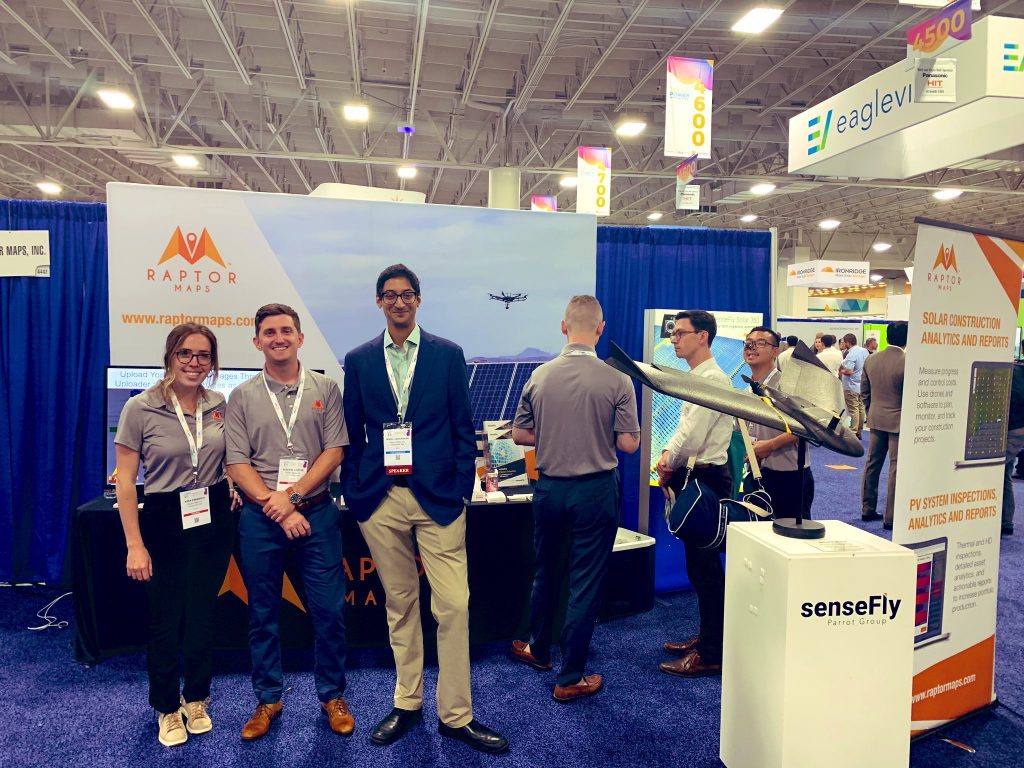The Impact
✈️ Drones For Solar Inspections
To: The Impact Readers
Good Evening 🧐
This week I learned that one of the main reasons solar & storage hasn’t grown as fast as some may hope is due to lack of true low cost financing. Basically, tax equity investors made a killing…but it did increase the cost of financing solar quite a bit. The Vox article that inspired this mini-research expedition.
Thank god that we have founders working on ways to make sure solar gets cheaper – via hardware innovation and software innovation. Hopefully we will reach a true 3% interest rate on loans to finance solar.
In Your Inbox: Drones for solar inspections; Nickel-Hydrogen Batteries; An interview with SolarX Works; and a recap of our interview with Aric!
🚀 STARTUPS & TECH
Solar Investments Flying to New Highs

Raptor Maps announced their $5M Series A raise, with investments from notable investors in the space: Blue Bear Capital, Data Point Capital, Buoyant Ventures, Congruent Ventures, Powerhouse Ventures, the Massachusetts Clean Energy Center, and Y Combinator.
“Our mission is to build software that enables the solar industry to scale,” says Nikhil Vadhavkar, CEO of Raptor Maps.
Raptor Maps provides tools to organize data, perform virtual inspections, and generate reports that seamlessly integrate into the workflows of solar asset owners.
Why does this matter?
- Raptor Maps provides a solution to assist with a 49% industry annual growth rate over the past decade.
- Since 2010, the cost of solar has decreased 85%, resulting in $1.3 trillion in solar investments, as well as an increase in capacity from 25 GW to 663 GW.
- To date, Raptor Maps has improved the project finance and asset management of over 25 GW in 35 countries.
- Raptor Maps’ solution applies has applications to site selection, surveying, build progress monitoring, and investment due diligence.
What’s next?
- As the solar investment tax credit (ITC) has started decreasing, there will be a need to cut costs of manufacturing, commissioning, and maintaining solar farms.
- Partners that work with Raptor Maps stand to benefit from process improvement and cost reductions.
- Raptor Maps is leading digitization of the solar industry. Not only will this accelerate innovation in the sector, but it will lead to decreased costs to develop and finance more solar farms.
Thoughts
Raptor Maps provides software and services to the solar industry that has great impact but is only part of the solution. It is what manufacturers do with the data and how they make improvements that will drive further growth – from decreasing costs, improving manufacturing practices, R&D into new and cleaner materials, etc. Investors should be focused on reducing carbon emissions, in addition to the transition to clean energy.
Sign up for The Impact and learn the perspectives behind the latest sustainability trends
🚀 STARTUPS & TECH
The Low Down On Nickel-Hydrogen Batteries

EnerVenue raised $12M in a seed round to commercialize Nickel-Hydrogen based batteries to compete with Lithium Ion for grid scale storage. Nickel Hydrogen offers unique advantages in thermal properties along with a long history of usage in the aerospace industry.
In fact Nickel-Hydrogen based batteries have been used to power the Hubble Telescope and used on board the International Space Station.
EnerVenue is a spin out from EEnotech led by Dr. Yi Cui – a Materials Scientist at Stanford and the company Founder.
Why Does This Matter?
- Lithium Ion batteries have been long challenged for safety concerns due to the potential issues caused by thermal runaway.
- Lithium based chemistries have issues due to the toxicity of the materials used in the cell itself
- Nickel-Hydrogen seems to bring low cost, established chemistry and high safety standards to a market that is begging for more ESS solutions
What’s Next?
- While lithium ion batteries have the majority of the global market for ESS covered people are actively watching flow batteries and various chemistries to see which one could beat the cost & safety standards Lithium Ion has set so far
- For any of these solutions to make it into the market cost will be a major deciding factor – unlike flow batteries – Nickel-Hydrogen is a chemistry that has been battle tested in harsh environments making it an ideal candidate to compete with lithium
- The challenge for EnerVenue will be overall system cost and project financing. If lenders begin to factor for batteries as a stand alone asset as opposed to utilizing it as an accessory to a solar farm to slightly enhance yields.
- Lifespan will become a huge differentiation in the market if lenders begin to develop and own grid scale ESS assets in regions where demand charges or resiliency is low – longer asset life provides a potential for a lower debt service to finance the batteries
Our Outlook On EnerVenue
There is never a shortage – especially the Summer of 2020 – in new battery storage ventures and chemistries coming to market that promise the world the ability to defeat Lithium Ion for all of its flaws.
EnerVenue has a strong team with a great background, but I believe the only route to success for ESS companies taking a stand as a manufacturer will come if they can pair it with wide scale financing. Utility contracts or POs will not be enough to carve out long term success from a market utilization stand point.
EnerVenue is a moonshot – but one that I believe has legs to become a true player in the global ESS market.
✨ COMPANY SPOTLIGHT
💨 Emissions Drop Across The World

This week, I talked with Blake Barthelmess, the CEO of SolarX Works. SolarX Works is bringing practical solar solutions to the world in an effort to make people’s lives better. SolarX Works was founded in 2015 and is currently field testing its prototype solutions with plans to ramp manufacturing in the near future. The company is currently working to secure industrial partners to broaden field test efforts.
As SolarX Works is focused on the cold chain, this conversation discusses areas to reduce organic waste along the supply chain, from the producer to the market.
Can you describe what your company does and the impact?
Our focus is on three things within the context of the food chain, specifically the cold chain: first mile, micro-distribution, and last mile.
First mile refers to the producer. The problem we are focusing on here is that in some parts of the world, up to 50% of the post-harvest is thrown away because there’s not an efficient means or infrastructure to get produce to the market – there’s no good method of cooling. Refrigeration is the key to preserving the quality of the integrity of the harvest. Within the domestic market, in field pre-cooling of produce yields higher quality, lower operating costs, and improved shelf-life.
The next focus area is micro-distribution. As shown by the current circumstances, supply chains have some weaknesses. There are inefficiencies in the supply chains which have led to shortages. To fix this problem, we are focused on enhancing the regional supply chain.
The third area of focus is last mile. Grocery stores operate on low margins, so anything you can do to offset costs helps. Refrigeration is very energy intensive, but solar can help offset that. Our solution is a cooling system that’s solar driven.
We started this business with the focus on the international concern to be able to improve the economic condition for producers, who is struggling with one of the following problems: water, access to available power, access to available cooling, and access to capital (microloans and money).
What is the current ecosystem/market landscape and who are the main players?
Right now, there are several international organizations and national organizations like the Millennium Challenge Corporation or USAID that are taking a look at cold chain infrastructure (going from pre-cooling in the field to a frozen warehouse that has refrigeration or freezing it back to the market, and investing to help build that infrastructure).
I see it as that we’re all part of the same kind of ecosystem trying to come up with a solution.
When we did our first proof of concept, we did exactly what others in the space did. We converted a refrigeration unit to run on solar. However, this was not the end goal because this can get expensive. We decided to be space agnostic, the goal is to convert any space into refrigeration.
We have patents around the physical design of the cooling system. Our technology takes 30 minutes to go from the back of a truck to blowing cold air.
Other companies are very specific and are complementary to us. To that point, there is potential to partner with others in the space such that SolarX Works focuses on the cooling piece, and we could license our technology.
What are the current trends in the sector? What does the future look like?
There is an estimated 70% of growth in required food supply globally over the next 20 years or so. At that rate, then we have to be able to distribute the food appropriately.
There’s going to be strain put on supply chains regardless of industry. You will see a shift away from monolithic cold storage buildings or warehouse distribution channels and more into micro-distribution channels on the regional level.
The greatest opportunity for impact to society is in nations that are developing. With solutions like SolarX Works, the price has to be adjusted so that international farmers, especially in Africa, can afford to leverage these kinds of solutions, where the infrastructure doesn’t exist. If we can deliver these kinds of solutions across thousands of villages, then things start to look different.
The return on an investment for smaller exports makes sense domestically. If producers can bring more produce to market, and the produce retains its integrity at market longer, producers can reduce their waste and improve their yield.
Our Outlook
Solutions that are consumer facing are great but are not enough on their own. There needs to be a bigger push for innovation in cold chain and supply chain. If farmers can reduce harvest loss and get more produce to markets, margins will grow along the distribution channels. This in combination with consumer facing solutions will have great impact in reducing waste, thus reducing greenhouse gas emissions.
📻 PODCAST UPDATES
How We Can Ingrain Car Sharing Into American Culture. With Aric Ohana
Aric is the CEO/Founder of Envoy There a startup making Electric Vehicles an amenity. Ian Sumner sits downs with Aric to learn about how car sharing can be ingrained into American Culture.
Check out and subscribe to our Youtube Channel for future episodes!
Writers: Swarnav S Pujari, Ian Sumner, Daniel Kriozere
If you aren’t absolutely thrilled with The Impact, reply and let us know why. Or you can unsubscribe from all updates by clicking here.
Copyright © The Impact 2020. All Rights Reserved || 19 Morris Ave, Bldg 128, Brooklyn NY 11205

